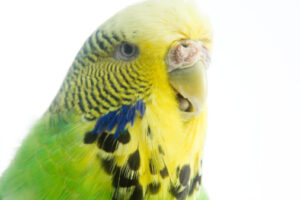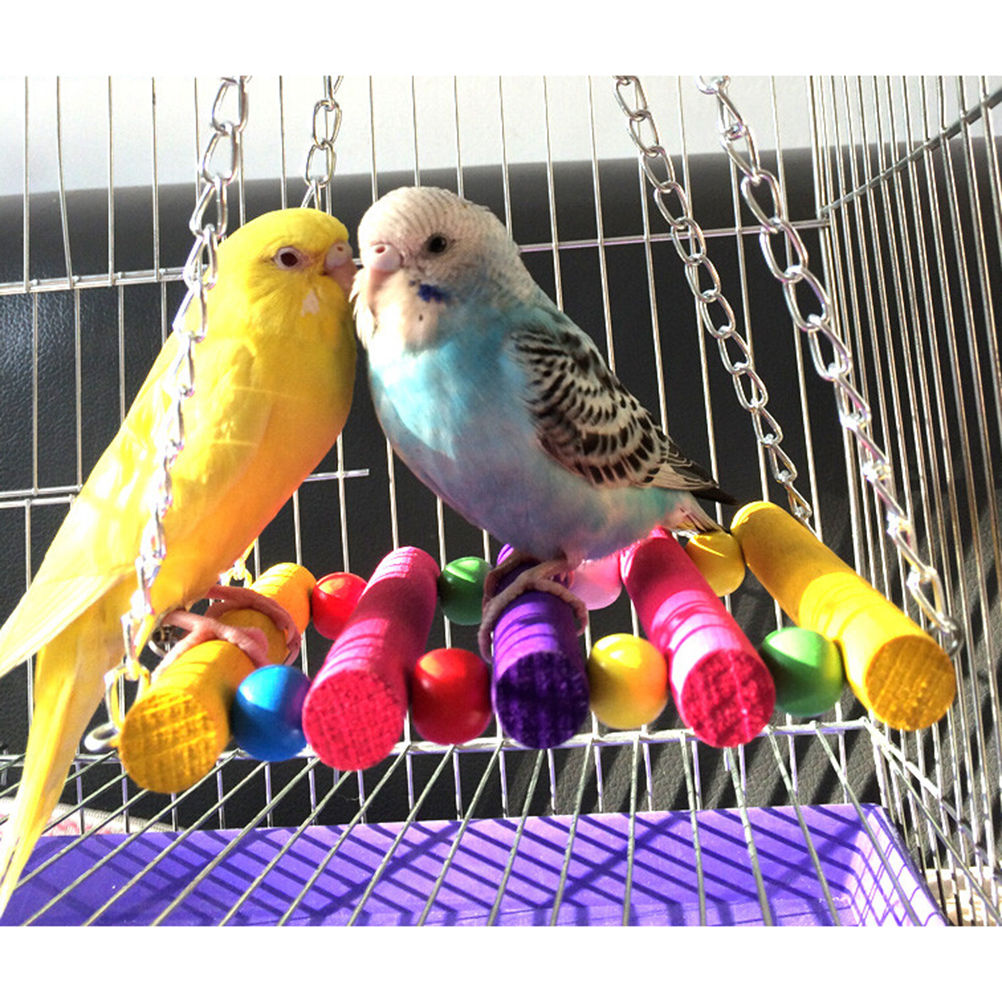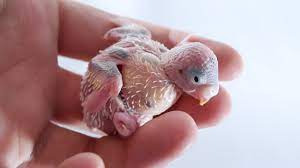
In order to raise and hatch Budgerigar, some things must be considered:
Making the cage
1- Select the size of the cage Suitable for hatchery Budgerigar
A cage is needed to raise Budgerigar. Choose a cage with a size of at least 61 cm by 41 cm by 41 cm. This size gives the bird enough space to fly and move. Although your birds enjoy being together, they also need time alone. A large cage allows them to be active and spend time away from their partner. Every pair at your disposal sometimes needs their own privacy.
2- Covering the cage floor with newspaper
Cover the floor of the cage and the openings of the iron bars with newspaper. These pores may make your birds uncomfortable, if you want to make the cage a cozy place for them to mate, the newspaper will be a safe and inexpensive option for the cage floor. In addition, your birds will enjoy tearing it.
Place two layers of newspaper on the bottom of the cage.

3- Placing the living room
Place two or more pieces of wood hanging in the cage. You will need more wood and seating so that both birds can use them. However, if cage space allows, your birds will enjoy more sticks and swings.
Wood is the best tool for building a living room. Avoid choosing separate plastic utensils because birds enjoy chewing anything in the cage.
4 – Put the nest in a cage
Attach a nest-shaped box measuring 15 cm by 15 cm by 25 cm to the side of the cage. It is better to use a box with one side open because it is easier to access safely. This nest-shaped box has a hole on one side that the female can easily enter. It then lays eggs inside, where the eggs are safe.
The nest shows how birds prepare to mate in the wild.
You can find the nest box from a local pet store or online or make your own.
5 – Put the concave container in the nest
Place a concave container inside the box to prevent the legs from breaking. Choose a container that is about 2.5 cm deep and 15 cm in diameter. The eggs are placed inside the container and this container helps to place them in the nest. The chicks then hatch from inside the head container, which provides a good surface for their legs.
Alternatively, you can make or buy boards and place them under the nest. The board should have a concave slope in its center.
Make sure the container is made of a non-toxic material such as wood or glass.
6- Putting straw in a container
Make a soft layer of wood chips inside the nest box. These wood chips are a means of nesting birds and create nature-friendly conditions for birds. The female bird also enjoys chewing on these pieces of wood and prepares for mating. In nature, females usually collect pieces of tree bark before fertilizing and chew it.
The bed should also be placed inside the concave part of the dish.
7- Cage cleaning for Breeding and hatchery Budgerigar
Clean the cage once a week. Empty bottles and containers, wash and refill. Remove the old bed and clean the cage. Replace the sleeping area with fresh crumbs and then replace the bottles and food container. Wash and dry any toys kept in cages.
If there are eggs inside the nest, do not change the litter until the chicks hatch. However, you can change the bed of the bird cage and replace it with new newspapers.
Complete feeding of Budgerigar to Breeding and hatchery Budgerigar
Our other articles:
Feeding the Budgerigar for hatchery Budgerigar
Another major step in raising Budgerigar is to feed them using healthy seeds and nutrients. In the following, we will introduce you to how to feed Budgerigar.
1- Making food
Fill an oversized party glass for a contemporary floral arrangement with pellets, seeds, fruits and vegetables. Use foods that are prepared exclusively for Budgerigar and always make this food available to them. Prepare a mixture of fresh seeds, fruits and vegetables twice a day. Always use fresh fruits and vegetables with smaller pieces for your bird. This will make your Budgerigar happy.
Some of the best fruits for Budgerigar include apples, bananas, blueberries, grapes, guava, kiwi, mango, melon, papaya, peaches, pineapples and strawberries.
Suitable vegetables also include broccoli, asparagus, Brussels sprouts, carrots, cauliflower, celery, cucumber, kale, pumpkin, radishes, spinach, squash, sweet potatoes, ripe tomatoes and cashews.
Budgerigar need more food after giving birth, so make sure their food is always full.
2- Making a drinking fountain
Hang two water bottles on the walls of the cage to ensure proper watering. Empty and refill water bottles every morning and evening to ensure the birds always have access to fresh water. Your Budgerigar need more water to reproduce. The best way to make sure the water does not run out is to use two bottles. In addition it reduces the risk of birds fighting over water.
Hang water bottles on both sides of the cage.
3- Providing enough food
Provide enough food so that parents do not feed on their eggs. Most Budgerigar do not eat their eggs, but if they feel they do not have enough food, they will be able to eat the eggs. Unfortunately, some birds get used to this after they first feed on their eggs. Budgerigar that continue to eat eggs after having enough food will not be good breeders. This issue will be discussed in detail in the article on feeding Budgerigar.
If Budgerigar eat their eggs, increase the amount of food in the cage during the next breeding season.
4- Supply of salts and minerals
To raise Budgerigar, nourish them with mineral capsules, sea urchin (squid bone) and iodized salt. These supplements provide the vitamins and minerals birds need, such as calcium. Put the supplements in a cage and let the birds eat them at will.
You can find these supplements in the pet store or online.

Encouraging Mating and hatchery Budgerigar
Matching Budgerigar
1- Early autumn to late spring is the best time for mating
Expect your birds to mate from October to June or when it rains. Budgerigar usually start mating in October or November and continue to do so until June. This may happen after heavy rains. In nature, after rain, their favorite food items are more available, so their chances of mating and reproduction increase. However, whenever it rains, there is a possibility that Budgerigar will reproduce.
2- Suitable room temperature
The temperature required for raising Budgerigar is to keep the room temperature between 65 and 75 degrees Fahrenheit (18 to 24 degrees Celsius). This interval is the best temperature for mating. You can use a heater or fan around the cage to adjust the temperature.
Cover the Budgerigar cage
3- Covering the cage at night
Cover the cage for 12 hours every night. Birds need rest to stay away from stress. Covering the cage creates a feeling of darkness and coziness for the bird and evokes the feeling of being in the nest. For the next 12 hours, remove the cage cover to allow the birds enough light.
Cover and open the cage evenly every day. For example, you can remove the cage cover at 6 o’clock in the morning and cover it again at 6 o’clock in the evening.
4- Cover the floor of the cage with wood chips
Cover the underside of the nest with crumbs so that the female can use it to chew. This helps him gain the spirit needed to reproduce and nest. Replace the chewed pieces with fresh ones so that the mother bird has clean pieces to chew.
This is a behavior that Budgerigar display in the wild before mating, so help your birds mate by encouraging them to do so. We suggest you watch the video of Budgerigar mating.
5- Observing the behavior of birds
Be careful of your birds’ reproductive behavior, this may be short and frequent. When the male is about to mate, he approaches the female with a chirping sound. Then it hits his beak. If the female also wants to mate, she lowers her head and raises her tail so that the male can find the right balance on her. They then mate, which does not take more than a few minutes.
Not every mating operation will produce fertile eggs, which is why birds repeat this process many times.
6- Spraying water
Spray the birds with water to evoke their natural reproductive conditions. Since Budgerigar mate after rain, spraying them with water can help. Spray the birds with water several times a day for several consecutive days to evoke rainy conditions. This encourages them to mate.
Their spray also helps to beautify their appearance and makes them touch each other with their beaks.
7. Leave the birds alone to hatchery Budgerigar
Leave the birds alone to mate. Do not inspect your birds constantly and do not leave their cages open regularly. Give them a chance to feel comfortable together and get ready to mate.
Do not let loud noise harass your Budgerigar. Do your best to create a calm environment.
Laying Budgerigar
Also know about cockatiels
Caring for Eggs and Chickens
After successful mating and a week to 10 days, you will see the first spawning in the female Budgerigar, and after the eggs reach 7 to 8, stop laying eggs and sleep on them to have healthy chicks. To give birth. During this time it will be your job to take care of the newborn eggs and chicks.

1- Wait until the female love hen lays eggs
After successful mating, wait 10 days for the first egg to be born. After the birds have mated and the eggs have been fertilized, the female lays her eggs on the tenth day. He lays one egg at a time so you only see one egg in the nest box.
Sometimes Budgerigar need to mate several times before the female eggs are fertilized .
2 – The amount of spawning will be between 4 to 8
The female love hen lays 4 to 8 eggs in two weeks. After the female has laid her first eggs, there is a gap of one to two days between each of her eggs. He continues to lay eggs daily or every two days until all the eggs are hatched. In total, it probably lays between 4 and 8 eggs.
She lays her eggs inside the nest box.
3- Ensuring that the Budgerigar sleeps on the egg
Make sure your Budgerigar sits on the eggs after the third spawning. The female does not sleep on her eggs until she has laid at least two or three eggs. This means that when the female first starts laying eggs, you will probably see one or two eggs in the nest that have been neglected. This is normal, so if your bird does not pay attention to its eggs for the first few days, there is no need to worry.
This is a female bird that always sits on the eggs. The male bird should never enter the nest box.
4 – Chickens come out after 21 days
Watch the chicks hatch 18 to 21 days after laying. When they start to hatch, cracks appear on the eggshell. It may take a while for the Budgerigar to hatch, but do not help them. If they are healthy, they will come out of their shells after a few hours.
If you have eggs that have not yet hatched after 22 days, it is best to throw them away. This will probably not work and if it does, the babies will not be healthy.
5. Make sure the mother Budgerigar takes care of the chicks
Budgerigar as children usually receive enough attention from their parents, but be careful that none of the children are neglected. If the number of children is large, the mother may not pay attention to the very small chicks. Therefore, it is better to give enough food to the Budgerigar during this period so that it will be full and feed the chickens. If the mother is unable to care for the chicks, you can raise the chicks using Serlak.
Conclusion :
In this article, we have prepared your Budgerigar breeding with prepare cages and feed and mate Budgerigar to hatchery Budgerigar.
Your valuable feedback will be effective in improving the content of the site.
Comments